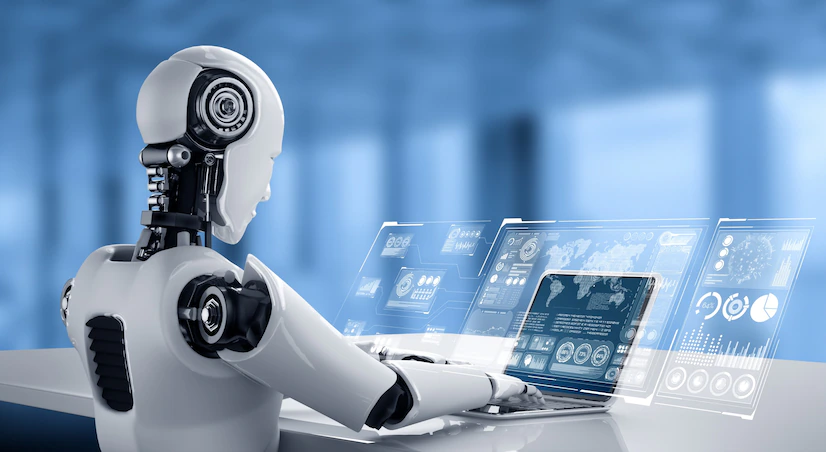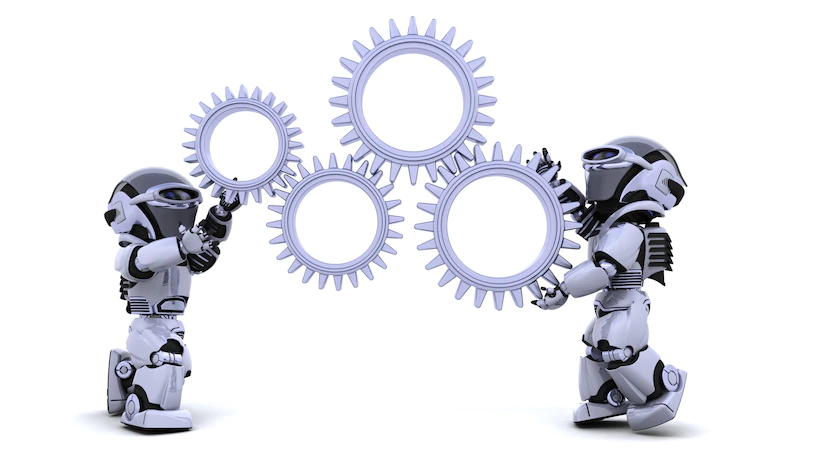14 Industries That Use Collaborative Robots

Are you interested in joining the collaborative robotics revolution? Robots that come together to create new working solutions have recently become a hot topic in the science community.
Collaborative robots are robotic devices that work alongside humans to perform tasks. They range from simple mechanisms such as industrial grippers to complex humanoid robots designed to assist workers with repetitive jobs.
The demand from manufacturing companies seeking ways to streamline their production processes has resulted in a surge in the adoption of collaborative robots.
The following industries have adopted collaborative robot technology for increased productivity.
Overview:
- Healthcare
- Pharmaceutical industry
- Oil and gas
- Aerospace and defense
- Agriculture
- Education industry
- Electronics
- Automotive
- Food industry
- Retail industry
- Mining
- Manufacturing
- Entertainment industry
- Construction
1. Healthcare
The healthcare industry needs many forms of help, especially for moving patients around. Collaborative robots can assist doctors with surgeries and other medical procedures.
Also, they can help disabled and older people remain independent because of their ease of use. These machines can match human movements and allow users to operate them effortlessly.
This automation helps to improve efficiency and reduce costs while simultaneously providing better healthcare.
2. Pharmaceutical industry
The pharmaceutical industry is a vast market. As it grows, many companies face challenges because of the high demand for new drugs and products. As a result, a need for rapid innovation and the development of new medicines arise.
But these innovations can take time and need extensive testing. Drug discovery is expensive and often requires dozens of tests to determine whether a particular drug can treat a specific condition.
But with the help of collaborative robots, pharmaceutical companies can reduce the time to test each potential drug. This allows them to identify a new drug much faster, creating a competitive advantage.
3. Oil and gas
Automation plays a significant role in the oil refining processes. As a result, the refinery sector has become highly automated. In refineries, collaborative robots can transport heavy cargo, such as pipes and tanks, through narrow spaces that would otherwise be unsafe for humans.
The machines are also used to clean the pipes and vessels. These robots significantly reduce the danger of accidents and injuries. So, the safety of workers improves.
4. Aerospace and defense
Aerospace and defense have used collaborative robots for a long time. In this industry, they are used to assemble plane parts and test out different weapons.
Using them eliminates the need for operators to work in dangerous environments, thus providing safer and better working conditions. Robots can also help fix planes and drone electronics that go wrong, saving lives and reducing downtime.
5. Agriculture
The Agriculture industry is a significant user of collaborative robots. They help farmers pick ripe fruits and vegetables. Agricultural robots can move through rows of crops and inspect each plant individually, then collect any fruits or vegetables falling out of reach.
It saves time and money for employees to return after picking them up. Farmers can control agricultural robots remotely from their office computers.
6. Education industry
The education sector widely uses collaborative robots. They help teachers in universities, colleges, and training centers teach various subjects, from basic math skills to programming. These robots read students’ minds and understand their meaning while writing assignments. That makes the work more accessible and more comfortable for teachers.
7. Electronics
The electronics industry has rapidly changed by introducing new technologies and innovations. The sector is embracing collaborative robots by allowing workers to use the tools like robots, but instead of performing tasks manually or semi-automatically, they work alongside them.
That eliminates hand fatigue and repetitive stress injuries, hence reducing costs. Besides, collaborative robots can improve quality control measures.

The future of our society depends on machines becoming smarter
8. Automotive
Automotive manufacturers are increasingly adopting collaborative robots to improve their manufacturing processes. In fact, some companies have already achieved substantial productivity gains from robots.
Robotic technology can also reduce human exposure to hazardous automotive materials. These systems provide higher accuracy and repeatability than traditional manual assembly methods.
9. Food industry
In food manufacturing facilities, collaborative robots can automate repetitive processes and pick operations. For example, humanoid robots are ideal in the food industry for their ability to work safely and efficiently.
They have many advantages over robotic devices, including greater speed, precision handling, and flexibility.
These machines can mix ingredients in bulk, dispense products into containers using a robotic arm, and package finished goods. They help reduce labor costs and time spent on a manual production line.
10. Retail industry
Retail stores need fast service and high customer satisfaction, but they can’t afford to hire many employees who take days off or leave early to get home. As a result, their workforce is understaffed.
As a result, many retailers have turned to collaborative technology to solve these issues. Collaborative robots assist employees in interacting with customers while providing information about products and services.
11. Mining
Robots have become extremely useful in the mining industry. They help in different stages of the operation, including exploration, extraction, transportation, logistics, and mineral processing.
Nowadays, robots can move around a mine with much greater speed and precision than before. They can work longer hours while performing their duties without tiring.
This automation in mining operations makes it possible to reduce the cost of production, increase productivity, and improve safety standards.
12. Manufacturing
Manufacturing companies use robot technology for inventory control and quality assurance testing. They can identify parts with defects by using sensors to scan items for flaws.
Automated inspection systems can detect defects from a distance and send images to computers. That eliminates human error and leads to less downtime for operators and greater productivity.
13. Entertainment industry
In the entertainment industry, collaborative robots can assist humans in performing tasks. These include assisting actors with body movement or speaking lines. A robot can act like a human to make people feel better about watching movies. Thus, it reduces the anxiety associated with watching movies.
14. Construction
The application of robotic technology has become prevalent in construction. These Robots appear in many aspects of project delivery, including site management, material handling, concrete placement, steel erection, bricklaying, and painting. These machines help to complete projects in less time while maintaining quality standards.
The future of our society depends on machines becoming smarter. That means robots will continue to serve us in various ways in the workplace and elsewhere. These robots will also be able to collaborate to solve problems in unexpected ways.
Additionals:
- 5 Factors to Consider When Developing Your Brand Personality
- 5 Best AI/RPA-Enabled Mobile Apps To Manage Your Finance Automatically

























Leave A Reply